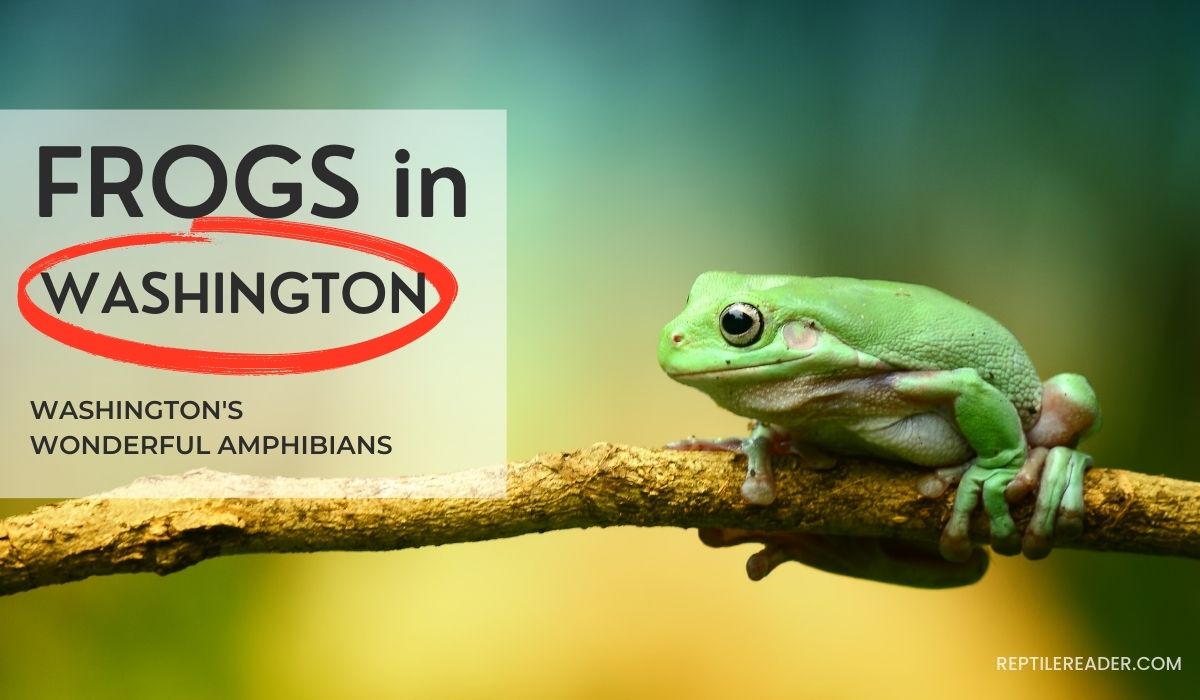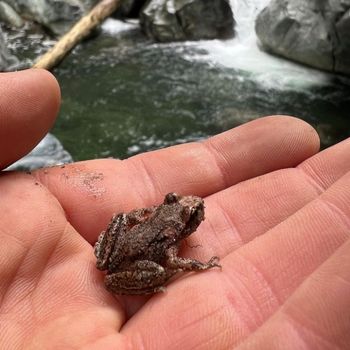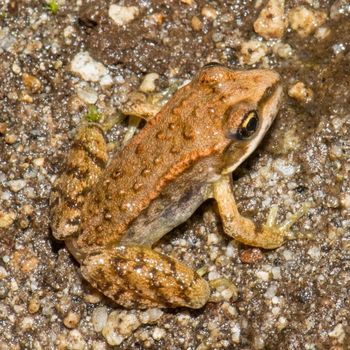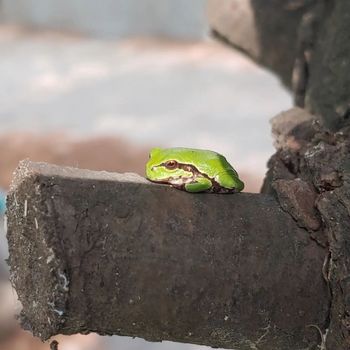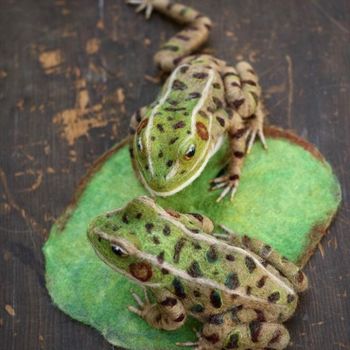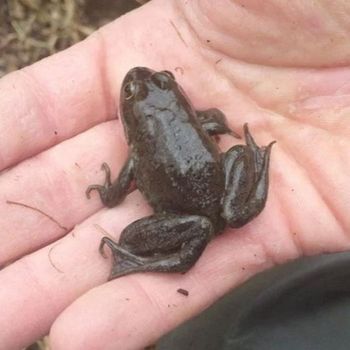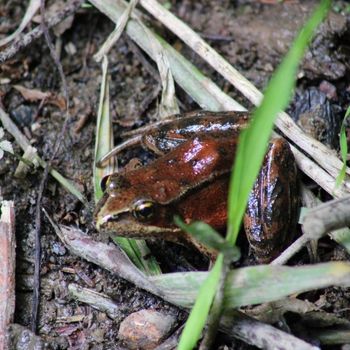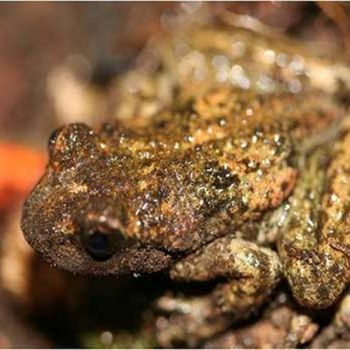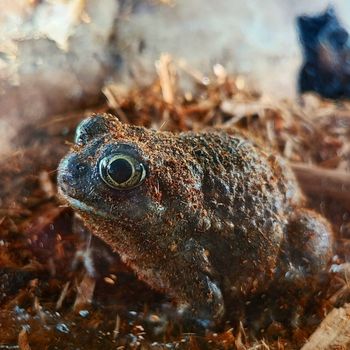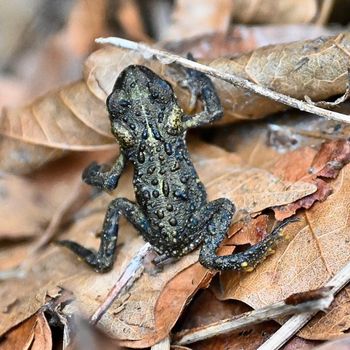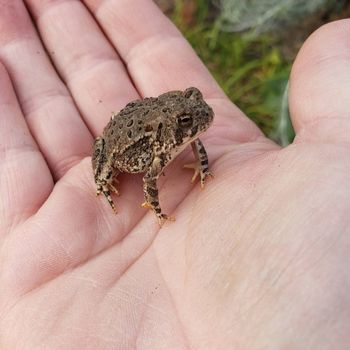Frogs in Washington: Washington’s Wonderful Amphibians
Hey, fellow amphibian lovers! If you’re anything like me, you have a special appreciation for the little croakers that inhabit our beautiful State of Washington. Did you know that Washington is home to an impressive number of frog species?
That’s right! In total, there are 13 unique species that can be found hopping around our state’s diverse ecosystems. From enchanting forests to lively wetlands, these little guys are thriving.
In this blog post, we’re going to hop right into knowing more about these captivating creatures. So, buckle up and get ready to explore the beautiful world of Washington’s diverse frog population.
| # | Name | Details | Image |
| 1 | American Bullfrog (Lithobates catesbeianus) |
| 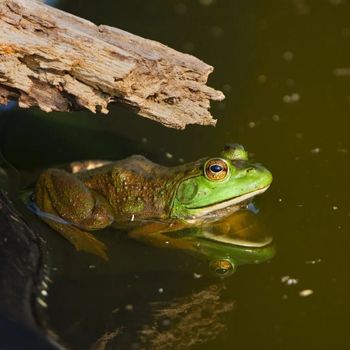 |
| 2 | Cascades Frog (Rana cascadae) |
| 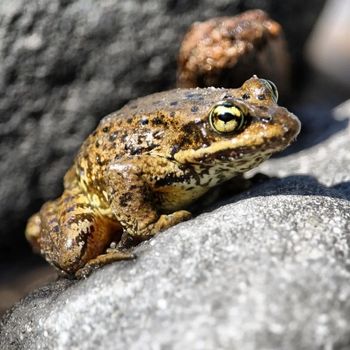 |
| 3 | Coastal Tailed Frog (Ascaphus truei) |
|  |
| 4 | Columbia Spotted Frog (Rana luteiventris) |
| 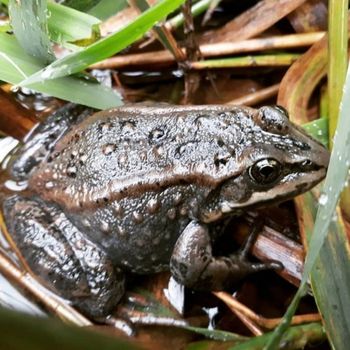 |
| 5 | Green Frog (Lithobates clamitans) |
| 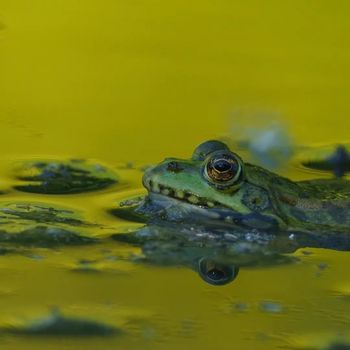 |
| 6 | Northern Leopard Frog (Rana pipiens) |
| 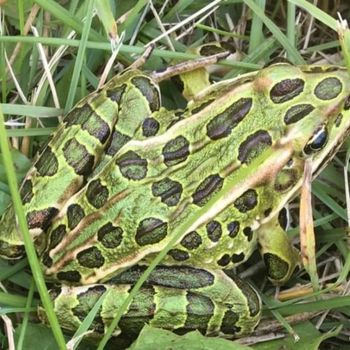 |
| 7 | Oregon Spotted Frog (Rana pretiosa) |
| 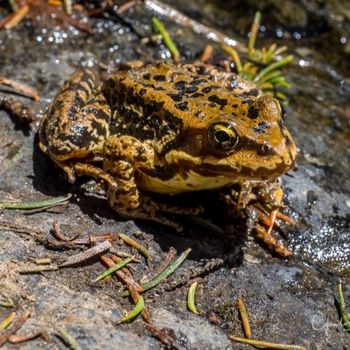 |
| 8 | Pacific Chorus Frog (Pseudacris regilla) |
| 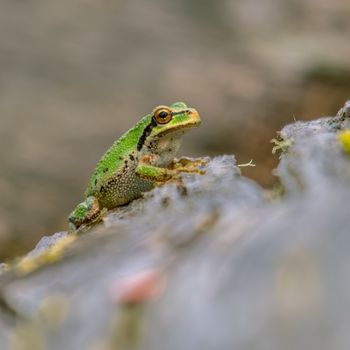 |
| 9 | Red-Legged Frog (Rana aurora) |
| 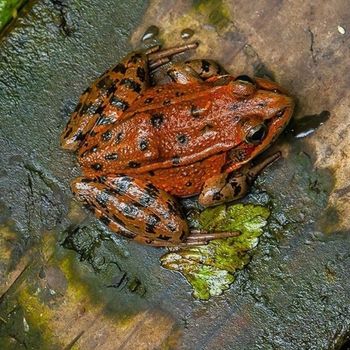 |
| 10 | Rocky Mountain Tailed Frog (Ascaphus montanus) |
| 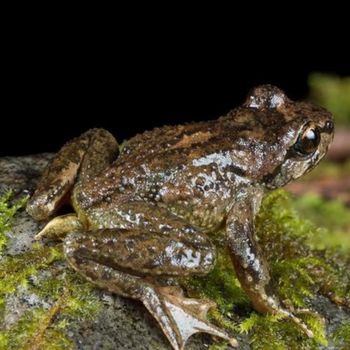 |
| 11 | Great Basin Spadefoot Toad (Spea intermontana) |
| 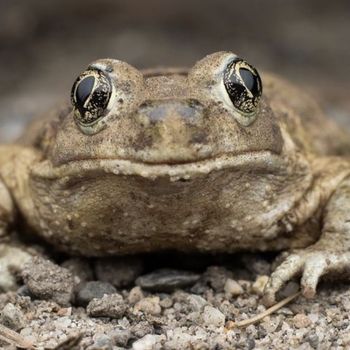 |
| 12 | Western Toad (Bufo boreas) |
|  |
| 13 | Woodhouse’s Toad (Anaxyrus woodhousii) |
|  |
13 Frog Species You Can Find in Washington
Get ready to dive deep into the lives of 13 incredible frog species that call Washington their home, showcasing their unique adaptations and remarkable behaviors.
1. American Bullfrog
- Scientific Name: Lithobates catesbeianus
- Common Name: American bullfrog
- Size: 3.5-6 inches (9-15 cm)
- Color & Pattern: Green to brown with dark spots and patterns
- Natural Habitat: Ponds, lakes, marshes, slow-moving streams
- Geographic Range: Eastern and central united states, canada, mexico, introduced worldwide
- Diet: Fish, crustaceans, insects, small mammals, birds, other amphibians
- Reproduction: Breeds in aquatic habitats, lays eggs in flat surfaces on water
- Vocalization: Deep, low-pitched calls by males during breeding
- Adaptation: Highly adaptable, strong legs for jumping and swimming
- Conservation Status: Least concern
Immerse yourself in the world of the American Bullfrog (Lithobates catesbeianus), a striking amphibian with a size ranging from 3.5 to 6 inches (9-15 cm). Adorned in a rich palette of green to brown, they exhibit dark spots and patterns which serve as excellent camouflage within their habitat. These aquatic creatures can leap and swim with grace and strength, due to their powerful legs.
Dwelling in the eastern and central United States, Canada, Mexico, and various regions around the world, they call ponds, lakes, marshes, and slow-moving streams their home. They satiate their hunger with a diverse diet of fish, crustaceans, insects, small mammals, birds, and other amphibians. The American Bullfrog is even known to be cannibalistic, predating on native species in introduced areas.
During breeding season, male Bullfrogs exclaim deep, low-pitched calls to attract mates, resulting in them laying their eggs in flat surfaces on the water for successful reproduction. Despite being a significant predator, their conservation status remains of least concern and they continue to thrive, showcasing their impressive adaptability. Delve deeper into the world of this fascinating amphibian, and uncover more about its unique quirks and captivating existence.
2. Cascades Frog
- Scientific Name: Rana cascadae
- Common Name: Cascades frog
- Size: 1.5-3 inches (4-7.6 cm)
- Color & Pattern: Brown or green with dark patches or spots
- Natural Habitat: Mountain streams, ponds, wet meadows
- Geographic Range: Northwestern united states (california, oregon, washington)
- Diet: Aquatic insects, beetles, snails, small invertebrates
- Reproduction: Breeds in aquatic habitats, lays eggs in submerged vegetation
- Vocalization: Soft, short calls or chirps by males during breeding
- Adaptation: Freeze-tolerance, hibernate underwater in oxygen-rich habitats
- Conservation Status: Near threatened
Meet Rana cascadae, commonly known as the Cascades Frog, a petite amphibian measuring only 1.5 to 3 inches in length. Adorned with a beautiful brown or green color and intriguing dark patches or spots, these captivating creatures inhabit the breathtaking landscapes of mountain streams, ponds, and wet meadows in the Northwestern United States, gracing the regions of California, Oregon, and Washington.
These tiny marvels have a voracious appetite for aquatic insects, beetles, snails, and small invertebrates. The amorous Cascades Frogs engage in aquatic courtship, with males displaying their charm through soft, short calls or chirps. They reproduce in their beloved water, laying their precious eggs amidst the sanctuary of submerged vegetation. Remarkably, these frogs that call Washington their home possess freeze-tolerance adaptations and can hibernate underwater in oxygen-rich habitats.
Though classified as Near Threatened, the Cascades Frog serves as an invaluable indicator species, attuning us to the health of their ecosystems. Their sensitivity to temperature changes embodies nature’s whispers, signaling environmental shifts often unnoticed by the human world. These magnificent miniature beings merit our attention, admiration, and protection, teaching us the importance of preserving the delicate balance of our collective home.
3. Coastal Tailed Frog
- Scientific Name: Ascaphus truei
- Common Name: Coastal tailed frog
- Size: 1-2 inches (2.5-5 cm)
- Color & Pattern: Greenish-brown, gray or dark brown with small, irregular spots
- Natural Habitat: Cold, fast-moving streams in forests
- Geographic Range: Western north america (california to british columbia)
- Diet: Aquatic insects, small invertebrates
- Reproduction: External fertilization, male clasps female, deposits sperm on eggs
- Vocalization: Males make feeble clicking noises
- Adaptation: Males have a tail-like extension for transferring sperm, can hold onto females with strong forelimbs
- Conservation Status: Near threatened
Hailing from the mystical wetlands of Western North America, the petite Coastal Tailed Frog (Ascaphus truei) boasts an enchanting appearance. Bedecked in greenish-brown, gray, or dark brown hues, these 1-2 inch amphibians are adorned with small, irregular spots, cleverly camouflaging them amongst the cold, fast-moving woodland streams they call home.
Unlike their fellow frogs, male Coastal Tailed Frogs master the art of seduction with a soulful serenade of feeble clicking noises. Engaging in a delicate dance of external fertilization, males expertly clasp females and deposit their sperm onto newly-laid eggs, aided by their signature tail-like extension and Herculean forelimbs. Their taste for aquatic insects and small invertebrates fuels their vigor in the pursuit of love.
Despite their ancient lineage, dating back over 100 years – earning the title of the oldest known living frog species – the Coastal Tailed Frog’s ethereal presence is near threatened. Resolute in their resistance to time, these captivating creatures continue to inspire the conservation of their habitat to ensure they continue enchanting generations to come.
4. Columbia Spotted Frog
- Scientific Name: Rana luteiventris
- Common Name: Columbia spotted frog
- Size: 1.5-4 inches (3.8-10 cm)
- Color & Pattern: Black, brown or green with irregularly shaped spots
- Natural Habitat: Wetlands, streams, lakes, ponds
- Geographic Range: Western north america (alaska to nevada)
- Diet: Aquatic insects, spiders, small invertebrates
- Reproduction: Breeds in quiet ponds, lays eggs in clusters attached to vegetation
- Vocalization: Low-pitched, rapid chuckling or clicking call by males during breeding
- Adaptation: Explosive jump for escape, webbing on hind feet for swimming
- Conservation Status: Least concern
From Alaska to Nevada, you’ll find these small amphibians – ranging from 1.5 to 4 inches in size – leisurely residing in wetlands, streams, lakes, and ponds. Their diet primarily consists of aquatic insects, spiders, and other small invertebrates hiding in their watery abodes.
Males of this elusive species serenade their female counterparts with low-pitched, rapid chuckling or clicking calls during breeding. You’ll find their eggs in clusters attached to vegetation within the serene waters of quiet ponds. Keep an eye out for their astonishing explosive jumps for escape, and watch them gracefully swim using the webbing on their hind feet – natural adaptations serving their survival in aquatic habitats.
Did you notice a flash of red or orange on the frog’s belly? That’s a distinctive feature of the Columbia Spotted Frog. Not only visually striking, but these little frogs are also essential to our understanding of wetlands, as they serve as a habitat indicator species. Although their conservation status is currently “least concern,” let’s celebrate and protect these incredible, vibrant creatures and the vital habitats they call home.
5. Green Frog
- Scientific Name: Lithobates clamitans
- Common Name: Green frog
- Size: 2.3-3.5 inches (5.8-8.9 cm)
- Color & Pattern: Dark green or olive green with small dark spots
- Natural Habitat: Ponds, marshes, lakeshores, slow-moving streams
- Geographic Range: Eastern united states and canada
- Diet: Aquatic insects, snails, crustaceans, small fishes
- Reproduction: Breeds in shallow freshwater habitats, lays eggs in clusters
- Vocalization: Deep, bass-like calls by males during breeding
- Adaptation: Highly aquatic, powerful hind legs for jumping and swimming
- Conservation Status: Least concern
Behold the vibrant Lithobates clamitans, better known to us earthlings as the Green Frog! Its striking, dark green or olive green hue, accented by tiny spots, easily captivates the eye – a stunning inhabitant of the ponds, marshes, lakeshores, and slow-moving streams across Eastern United States and Canada. This exquisite amphibian masters the art of camouflage with a size ranging from 2.3 to 3.5 inches (5.8-8.9cm).
As a natural-born gourmet, the Green Frog feasts on a delectable menu of aquatic insects, snails, crustaceans, and small fishes. Cunning and creative, it seeks out shallow freshwater habitats for breeding, laying clusters of eggs as a part of its ingenious reproduction cycle. And, oh, how they serenade! The males’ deep bass-like calls enchant during the breeding season, as their bright yellow vocal sacs visually delight.
Frogs that are designed to jump and swim with their powerful hind legs, these phenomenal creatures are highly aquatic by nature. Perhaps the most fascinating facts linger in their ability to magically regenerate lost limbs, forming an extraordinary evolutionary edge. Fear not for their future, as they are classified with a conservation status of “Least Concern.” Our enchanting Green Frog will continue to leap and swim, astonishing us for years to come.
6. Northern Leopard Frog
- Scientific Name: Rana pipiens
- Common Name: Northern leopard frog
- Size: 2.0-4.3 inches (5.1-11 cm)
- Color & Pattern: Green or brown with dark spots circled by a lighter border
- Natural Habitat: Marshes, swamps, grasslands, wetlands
- Geographic Range: Canada and the united states (alaska to new mexico)
- Diet: Insects, spiders, small crustaceans, other invertebrates
- Reproduction: Breeds in shallow, well-vegetated freshwater habitats, lay eggs in clusters attached to vegetation
- Vocalization: Snore-like call by males during breeding
- Adaptation: Long, powerful legs for jumping, partially webbed hind feet for swimming
- Conservation Status: Least concern
These captivating creatures are perfectly suited for life in marshes, swamps, grasslands, and wetlands, stretching from Alaska to New Mexico in North America. Their partially webbed hind feet allow them to swim gracefully, while their long, powerful legs support impressive jumping abilities.
With a main diet of insects, spiders, small crustaceans, and other invertebrates, these voracious eaters keep their habitats in Washington lively. During breeding season, these frogs settle in shallow, well-vegetated freshwater habitats, and females lay eggs in clusters attached to vegetation. To attract a mate, male frogs serenade their companions with a unique, snore-like vocalization.
Remarkably, the Northern Leopard Frog is capable of surviving being frozen, an unparalleled adaptation contributing to their classification as “Least Concern” in conservation statuses. However, it is worth noting that habitat loss may lead to a decline in future populations. Overall, these fascinating frogs continue to enchant us with their beauty, resilient nature, and captivating behaviors.
7. Oregon Spotted Frog
- Scientific Name: Rana pretiosa
- Common Name: Oregon spotted frog
- Size: 1.5-4 inches (3.8-10 cm)
- Color & Pattern: Brown or green with black spots, dark mask over eyes
- Natural Habitat: Wetlands, marshes, slow-moving streams
- Geographic Range: Pacific northwest (california to british columbia)
- Diet: Aquatic insects, small invertebrates
- Reproduction: Breeds in shallow water areas, lays eggs in floating clumps
- Vocalization: Low-pitched, distinctive series of rapid short calls by males during breeding
- Adaptation: Can tolerate low oxygen levels in water, strong leg muscles for jumping
- Conservation Status: At-risk, federally threatened in the united states
Adorned in earthy shades of brown or green and accented with black spots and a mysterious dark mask over its eyes, this charming amphibian ranges from 1.5 to 4 inches in size. Its distinctive low-pitched serenade can be heard resonating throughout the lush wetlands, marshes, and slow-moving streams of the Pacific Northwest, from California all the way up to British Columbia.
A vital member of the aquatic ecosystem of Washington, the Oregon Spotted Frog has a penchant for devouring aquatic insects and small invertebrates. These nimble jumpers exhibit remarkable adaptations to their environment, including the ability to tolerate low oxygen levels in water and strong leg muscles for making great leaps. When it comes to reproduction, Rana pretiosa stands out from its amphibious counterparts, laying its eggs in floating clumps earlier in spring and exclusively within permanent aquatic habitats.
Despite its incredible adaptability, the Oregon Spotted Frog’s existence now hangs in the balance, classified as at-risk and federally threatened in the United States. It is crucial that we safeguard these unique creatures and their habitats in the face of the many challenges threatening their survival.
8. Pacific Chorus Frog
- Scientific Name: Pseudacris regilla
- Common Name: Pacific chorus frog
- Size: 0.75-2 inches (1.9-5 cm)
- Color & Pattern: Variable green, tan, or brown with dark stripe through the eye
- Natural Habitat: Moist forests, grasslands, wetlands, urban areas
- Geographic Range: Western north america (alaska to baja california)
- Diet: Insects, arachnids, small invertebrates
- Reproduction: Breeds in shallow water, eggs attached to vegetation
- Vocalization: Males produce cricket-like calls during breeding
- Adaptation: Camouflage, ability to change color, survival in varied habitats
- Conservation Status: Least concern
Amidst the myriad hues of western North America’s moist habitats resides the ever-adaptable Pacific Chorus Frog (Pseudacris regilla). Stretching from the chilly vastness of Alaska to the arid Baja California, these petite creatures measure a mere 0.75-2 inches, boasting a stunning array of variable green, tan, and brown colors adorned with a striking dark stripe through their eyes.
In forests, grasslands, and wetlands alike, the elusive Pacific Chorus Frog evades capture with its camouflage and remarkable ability to change color. These frogs feast on insects, arachnids, and small invertebrates, playing a crucial role in insect control for the state of Washington. Swarming to shallow waters for breeding, their cricket-like vocalizations evoke a melody of love, as the males beckon their partners and lay eggs amidst the protective embrace of vegetation.
The Pacific Chorus Frog’s resilience to freezing temperatures and varied habitats contribute to their conservation status being of least concern, leaving no doubt about their exceptional adaptability. Hopping surreptitiously through the foliage, these small wonders remind us of nature’s ability to survive and thrive, their diverse colors and patterns a testament to the splendor of adaptation.
9. Red-Legged Frog
- Scientific Name: Rana aurora
- Common Name: Red-legged frog
- Size: 1.5-4 inches (3.8-10 cm)
- Color & Pattern: Brown or reddish-brown with black spots or blotches
- Natural Habitat: Forests, marshes, woodlands, grasslands
- Geographic Range: Western north america (alaska to baja california)
- Diet: Insects, spiders, smaller amphibians
- Reproduction: Breeds in still water, lays egg masses on submerged vegetation
- Vocalization: Low-pitched, repetitive calls by males during breeding
- Adaptation: Long legs for high jumping, webbed feet for swimming
- Conservation Status: Near threatened
This alluring amphibian measures a petite 1.5-4 inches, and sports a captivating brownish or reddish-brown hue adorned with mystifying black spots or blotches. Residing in the diverse habitats of forests, marshes, woodlands, and grasslands, this striking creature leaps through its western North American home, from Alaska to Baja California.
Our fine froggy friend feasts on a diet of insects, spiders, and even smaller amphibians, but charming Rana aurora doesn’t just focus on food. During reproduction, these captivating creatures breed in still waters and daintily lay their egg masses on submerged vegetation. Males serenade their lovers with low-pitched, repetitive calls as they take part in the time-sensitive ritual.
Though they boast long legs for high jumping and webbed feet for swimming, Red-Legged Frogs face near-threatened conservation status due to their sensitivity to pollution and habitat loss. Despite these challenges, these enigmatic creatures hold the proud title of California’s state amphibian. So, let’s hop to it and join the chorus cherishing our beloved Red-Legged Frogs!
10. Rocky Mountain Tailed Frog
- Scientific Name: Ascaphus montanus
- Common Name: Rocky mountain tailed frog
- Size: 1-2 inches (2.5-5 cm)
- Color & Pattern: Brown, gray, or green with darker mottling or spots
- Natural Habitat: Cold, clear, rocky streams in mountainous regions
- Geographic Range: Northern idaho, montana, and northeastern washington
- Diet: Aquatic insects like mayflies, stoneflies, and small invertebrates
- Reproduction: Internal fertilization, female lays eggs under rocks in streambeds
- Vocalization: Males do not have vocalizations
- Adaptation: Tailed frog tadpole has unique oral disc for grazing algae on rocks, adults have unique “tail” or sperm delivery
- Conservation Status: Least concern
Often found hiding within the cascading waters of northern Idaho, Montana, and northeastern Washington is the enchanting Rocky Mountain Tailed Frog (Ascaphus montanus). Wrapped in a cloak of varying shades like brown, gray, or green with darker mottling or spots, these 1-2 inch beings are a tribute to the oldest frog lineage that dates back 150 million years ago.
Their fascinating features include the presence of a unique ‘tail’ that aids in sperm delivery and a special oral disc found only in tailed frog tadpoles, meant for grazing algae on rocks. These timeless creatures thrive in cold, clear, rocky streams of mountainous regions while sustaining themselves on aquatic insects, mayflies, stoneflies, and other small invertebrates. Stealthily laying their eggs under rocks within streambeds in Washington, these frogs embody the essence of the wild, where males exercise silence, seemingly in reverence to the circles of life.
Presently, their conservation status is not under threat, and nature lovers can revel in the knowledge that the Rocky Mountain Tailed Frog continues to thrive in its pristine alpine homes. Secrets whispered by water currents carry the tales of these ancient beings, reminding us that nature’s history is etched in the smallest of its inhabitants.
11. Great Basin Spadefoot Toad
- Scientific Name: Spea intermontana
- Common Name: Great basin spadefoot toad
- Size: 1.5-3 inches (3.8-7.6 cm)
- Color & Pattern: Green to brown with dark spots, light-colored stripe along spine
- Natural Habitat: Sagebrush, grasslands, desert scrub
- Geographic Range: Southwestern canada, western us
- Diet: Insects, spiders, small invertebrates
- Reproduction: Breeds in temporary pools, lays eggs attached to vegetation
- Vocalization: Males make low-pitched chirping noises during breeding
- Adaptation: Spade-like appendages on hind feet for digging, can secrete toxin from skin
- Conservation Status: Least concern
Donning hues of green to brown, decorated with mysterious dark spots and an elegant light-colored stripe down its spine, this small creature measures just between 1.5-3 inches. Roaming the sagebrush, grasslands, and desert scrub landscapes of Washington, this petite amphibian can be found spreading its charm throughout the southwestern expanses of Canada and the western US.
Always on the hunt for delicious insects, spiders, and small invertebrates, the Great Basin Spadefoot Toad knows how to survive. But once it’s time for reproduction, this little wonder seeks out temporary pools to lay its eggs, carefully attaching them to nearby vegetation. During the breeding season, males serenade their partners with low-pitched, harmonious chirping noises.
Possessing impressive adaptations, the Spea intermontana is well-equipped for its environment. Its hind feet showcase spade-like appendages for digging, and they can even secrete toxins to discourage predators. This extraordinary toad goes into aestivation during dry periods, shedding its skin in a unique “cocoon” during emergence. With a conservation status of “least concern”, it seems, for now, the enchanting Great Basin Spadefoot Toad is here to stay.
12. Western Toad
- Scientific Name: Bufo boreas
- Common Name: Western toad
- Size: 3-5 inches (7.6-12.7 cm)
- Color & Pattern: Brown, gray, green, or olive with dark blotches; light dorsal stripe
- Natural Habitat: Forests, meadows, wetlands, and grasslands
- Geographic Range: Western north america (from alaska to mexico)
- Diet: Insects, spiders, worms, small invertebrates
- Reproduction: Breeds in freshwater habitats, lays eggs in long strings
- Vocalization: Low-pitched short trills by males during breeding
- Adaptation: Glands secrete toxin, can breed in ephemeral ponds
- Conservation Status: Near threatened
This small yet fascinating creature ranges from 3 to 5 inches in size, boasting a captivating palette of brown, gray, green, or olive hues, adorned with dark blotches and a striking light dorsal stripe. Their nocturnal nature adds a certain air of mystery, as they dig burrows and hibernate during the biting winter months.
Making their homes in forests, meadows, wetlands, and grasslands, these toads have claimed an extensive territory spanning western North America—from the frosty expanse of Alaska to the sun-soaked stretches of Mexico. Known for their carnivorous appetite, Western Toads feast on insects, spiders, worms, and other small invertebrates, ensuring a balanced ecosystem in their diverse habitats. The low-pitched short trills of males during breeding season prove they are nothing if not romantic.
These fascinating creatures have uniquely adapted to their environment; glands in their skin secrete a powerful toxin to ward off predators, and their ability to breed in ephemeral ponds showcases their resilience. However, Western Toads are currently considered near threatened, emphasizing the need for diligent conservation efforts. Their captivating story serves as a stark reminder for us to appreciate the beauty and complexity of the wild.
13. Woodhouse’s Toad
- Scientific Name: Anaxyrus woodhousii
- Common Name: Woodhouse’s toad
- Size: 2-5 inches (5-12.7 cm)
- Color & Pattern: Gray, green, or brown with dark blotches, light-colored midline stripe
- Natural Habitat: Grasslands, shrublands, forests, agricultural fields
- Geographic Range: Western north america (from southern canada to northern mexico)
- Diet: Insects, spiders, and other small invertebrates
- Reproduction: Breeds in temporary or permanent bodies of water, lays eggs in long strings
- Vocalization: Males produce a long, nasal trill during breeding season
- Adaptation: Parotoid glands secrete bufotoxin, good burrowers
- Conservation Status: Least concern
Anaxyrus woodhousii, commonly known as Woodhouse’s Toad, is a small and adaptable amphibian found throughout western North America – from the fields of southern Canada to the forests of northern Mexico. Measuring 2-5 inches in length, this friendly toad boasts a mottled gray, green, or brown appearance with dark blotches and a distinctive light-colored midline stripe down its back.
This resourceful creature thrives in a range of habitats, from grasslands and shrublands to forests and agricultural fields. They enjoy a hearty diet of insects, spiders, and other small invertebrates. During the breeding season, male Woodhouse’s toads serenade their potential mates with a long, nasal trill, laying their eggs in lengthy strings within temporary or permanent bodies of water.
The Woodhouse’s Toad is well adapted for survival, possessing parotoid glands that secrete a potent toxin called bufotoxin to deter predators. They are also adept burrowers, easily creating underground shelters. Although their conservation status is currently listed as “least concern,” their populations have been impacted by pesticide use. This versatile and resilient toad continues to play an essential role in our diverse North American ecosystems.
Nearby States:
Are the Frogs in New York and Washington Similar in Behavior and Habitat?
Frogs in New York and Washington share similarities in behavior, especially in their nocturnal activities. The urban and wetland environments allow them to adapt similarly, with frogs thriving in new york at night, using darkness to hunt for food and avoid predators, just like their counterparts in Washington’s habitats.
Are Any Frog Species Found in Both Washington and Wisconsin?
Several frog species inhabit both Washington and Wisconsin due to their similar wetland habitats. These include the Northern Leopard Frog, which thrives in both states’ marshes and ponds. Many wisconsin frog species share environmental preferences with Washington’s amphibians, benefiting from access to freshwater ecosystems in both regions.
What Types of Frogs Can Be Found in Washington and Arkansas?
In recent years, frogs in arkansas uncovered a range of species, including the American bullfrog, green frog, and Cope’s gray treefrog. Meanwhile, in Washington, you can find the Pacific treefrog, red-legged frog, and the Cascades frog. These diverse species enrich the local ecosystems and contribute to the region’s biodiversity.
Final Words
In summary, Washington boasts a remarkable array of 13 diverse frog species, displaying a kaleidoscope of colors, patterns, and unique adaptations. Embark on a fascinating journey through their habitats, appreciating their distinctive vocalizations, and uncover the secret lives of these magnificent amphibians that grace the state of Washington.

